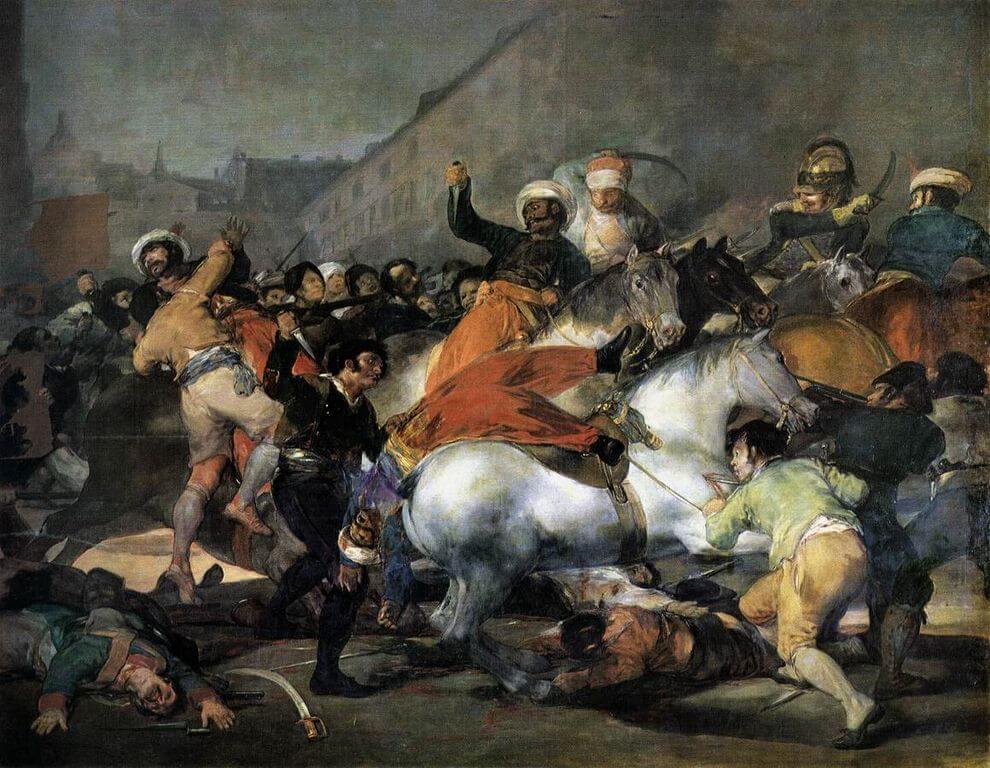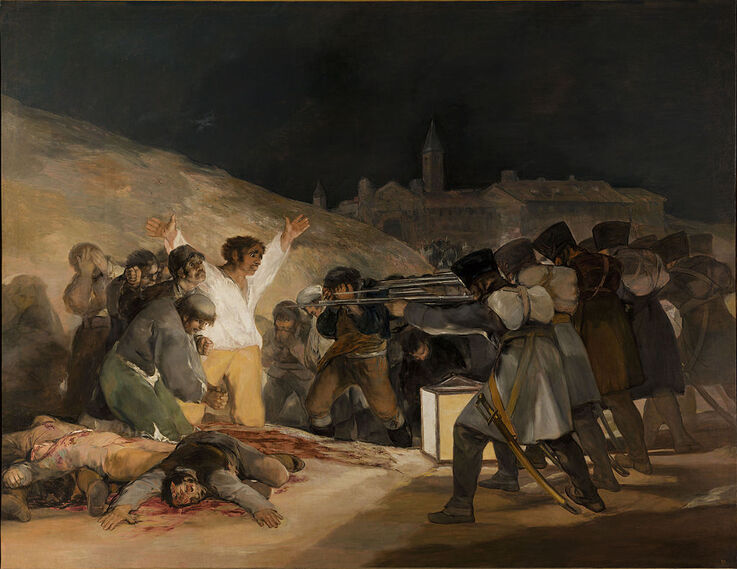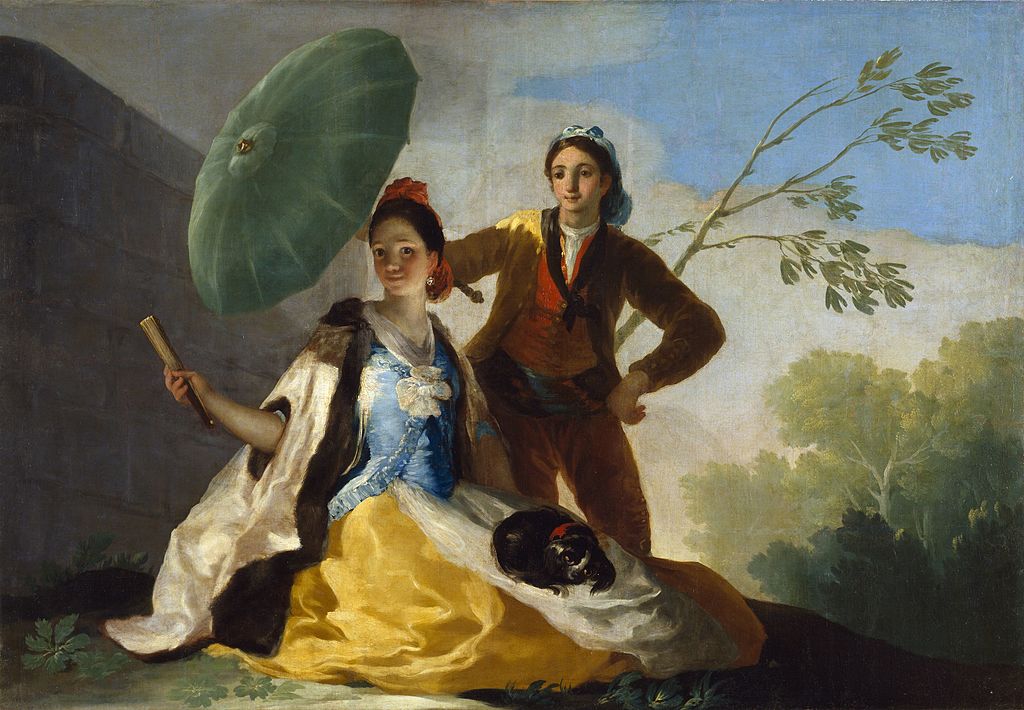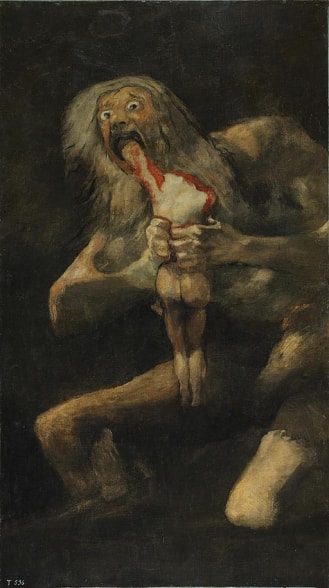|
Where? Room 64 of the Prado Museum
When? 1814 Commissioned by: The Spanish government What do you see? A scene of a street fight. Napoleon’s Turkish soldiers, the Mamelukes, ride on horses, arms raised with swords. They are recognizable in their turbans and black uniforms. Some of them wear blue shirts and red pants. On the ground are the outnumbered citizens of Madrid. They are peasants and common people recognizable by the dull rags that they wear. A man that appears to be a Spanish soldier stands on the right side in a black uniform. He points his gun towards one of the Mamelukes. In the foreground, a man stabs a white horse as another man on the left raises his arm to stab its rider. Beneath the horse are two dying rebels. Behind, a peasant tackles a Mameluke, jumping off the ground to attack. The numerous blurred faces in the middle ground add to the chaos of the scene. Although the scene looks like a Spanish triumph, the reality of the story is not so. Backstory: This painting commemorates a true historical event. In this work, Goya shows one of many street fights that broke out on the second of May, 1808, when Spanish citizens rebelled against the French occupation. The Spanish people that rebelled during that day were executed by French firing squads on the next day, and Goya captured that event in a separate painting called The Third of May 1808 which is also in the Prado Museum. The painting of The Second of May 1808 is crammed with the bodies of Mamelukes, Spaniards, and horses that tangle to make for a very chaotic scene. The moment is dramatized with the harsh light on the white horse in the center of the painting and the subtle diagonal drawn from the cadaver (bottom left) to the two soldiers with raised weapons (right of center). The work also uses lighter colors and bright reds that put it in direct opposition to The Third of May 1808, which uses darker tones. Goya puts an emphasis on the sacrifice of the Spanish rebels, showcasing their heroism.
May 2, 1808: This was the day that many citizens of Madrid rebelled against the French occupation. Crowds assembled around the Royal Palace of Madrid to protest the French occupation. The French soldiers opened fire on the crowds, triggering street fights and rebellion in other parts of the city. The French armed forces outnumbered the Spanish citizens. When the conflict had subsided, hundreds of Spanish citizens had died. Many survivors were taken prisoner for execution the next day.
May 3, 1808: The day after the Spanish rebelled against the French army, the rebels were executed by French firing squads. Many surviving Spanish rebels were gathered and shot in several locations in Madrid. Supposedly, most of the executed rebels were peasants, artisans, and beggars. About one hundred deaths by firing squads were reported. Goya captured the events on this day in his painting The Third of May 1808, which is also in the Prado Museum. Who is Goya? Francisco Goya was born in 1746 in Fuendetodos in the Northeast of Spain and died in 1828 in Bordeaux, France. He studied drawing and painting in Zaragoza and joined the studio of José Luzán. Later, he studied under Francisco Bayeu Subías who led him to work on decorations for the royal palace. Goya married Subías’s sister and traveled to Italy after failing in two drawing competitions at the Real Academia des Bellas Artes in San Fernando. Eventually, Goya was appointed painter to the Royal Tapestry Factory in Madrid. His work was reminiscent of Rococo art and focused on day-to-day events. As his work gained more attention, Goya rose to the position of court painter to King Charles III and Charles IV. His style was cheerful and warm and included paintings like The Parasol in the Prado Museum. But around 1793, he fell ill and became deaf. After this, Goya’s work became filled with darkness, ghosts, and monsters. An example of such a dark painting is Saturn Devouring His Son, which is also in the Prado Museum.
Fun fact: During the Spanish Civil War between 1936 and 1939, the collection of the Prado Museum was moved to the League of Nations in Geneva. The truck transporting some of Goya’s works was caught in an accident as it was passing through Girona. The Second of May 1808 and The Third of May 1808 were stored together, and both suffered quite a blow. However, The Second of May 1808 suffered more damage. In the process, the canvas of this painting was damaged. Small pieces of the canvas fell off the left side and were lost on the road. Tear marks and scratches are still visible on the left side of the work despite restoration efforts in 1941, 2007, and 2008.
Written by Sabrina Tian
References:
0 Comments
Leave a Reply. |
Categories
All
|
- Home
- Blog
-
Museums
- Alte Pinakothek
- Art Institute of Chicago
- Baltimore Museum of Art
- Barber Institute of Fine Arts
- Bargello
- Barnes Foundation
- British Museum
- Church of Sant’Anastasia
- Cleveland Museum of Art
- Courtauld Institute of Art
- Detroit Institute of Arts
- Frans Hals Museum
- Galleria Borghese
- Gallerie dell'Accademia
- Getty Museum
- Guggenheim
- Hermitage Museum
- Kunsthistorisches Museum
- Kunstmuseum Basel
- Legion of Honor Museum
- Louvre
- Mauritshuis
- Metropolitan Museum of Art
- Musee d’Orsay
- Museum of Fine Arts in Boston
- Museum of Modern Art
- National Gallery in London
- National Gallery of Art
- National Museum in Poznań
- Norton Simon Museum
- Ny Carlsberg Glyptotek
- Palace of Versailles
- Palazzo Pitti
- Palazzo Vecchio
- Petit Palais
- Philadelphia Museum of Art
- Prado
- Pushkin Museum
- Ravenna Art Museum
- Rijksmuseum
- San Diego Museum of Art
- Santa Maria delle Grazie
- St. Peter's Basilica
- Städel Museum
- Statens Museum for Kunst
- Tate Britain
- Tate Modern
- Timken Museum of Art
- Uffizi
- Vatican Museums
- Wallace Collection
-
Artists
- Altdorfer
- Anguissola
- Berlin Painter
- Bosch
- Botticelli
- Boucher
- Bronzino
- Bruegel the Elder
- Brunelleschi
- Cabanel
- Caillebotte
- Canova
- Caravaggio
- Carpeaux
- Cezanne
- Cimabue
- David
- Degas
- Delacroix
- De Maria
- Donatello
- El Greco
- Fontana
- Fra Angelico
- Fragonard
- Gauguin
- Gentileschi
- Gericault
- Gonzalez-Torres
- Goya
- Hals
- Hogarth
- Hokusai
- Ingres
- Leonardo da Vinci
- Lippi, Filippo
- Longhi, Barbara
- Lorrain
- Makovsky
- Manet
- Massys
- Matisse
- Merian
- Michelangelo
- Mochi
- Modigliani
- Monet
- Panini
- Parmigianino
- Perugino
- Picasso
- Pisanello
- Raphael
- Rembrandt
- Renoir
- Reynolds
- Rivera
- Rodin
- Rubens
- Scultori
- Seurat
- Steen
- Tintoretto
- Titian
- Toulouse-Lautrec
- Turner
- Uccello
- Van der Weyden
- Van Dyck
- Van Eyck
- Van Gogh
- Van Hemessen
- Vasari
- Velazquez
- Vermeer
- Veronese
- Vigée Le Brun
-
Locations
- Books
- About Us




